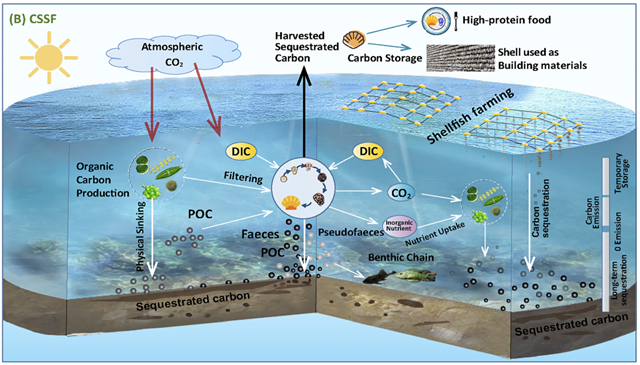January, 2023 | Renewable and Sustainable Energy Reviews | Source |
Introduction: Achieving global climate goals requires practical, low-energy negative emissions technologies (NETs). Researchers from Guangdong University of Technology (China) and Malardalen University (Sweden) assess the carbon sequestration potential of bivalve shellfish farming (CSSF). Using comprehensive analysis, the study evaluates CSSF’s effectiveness in COâ absorption and long-term storage, its net carbon sink status over the full life cycle, and its performance compared to ecosystems like artificial forests and mangroves.
Key findings: Shellfish farming presents substantial potential as a carbon-negative technology. Between 2015–2019, cultivation in China sequestered approximately 6.23 million tons of COâ equivalent annually, with oyster farming contributing about 84%. Life cycle analysis confirms shellfish farming is a net carbon sink, as captured carbon offsets emissions across all stages. Net sequestration ratios for key species (12.55% to 33.68%) far exceed those in natural systems (<1%), and carbon storage via CaCOâ formation and sediment deposition remains stable for over 100 years. Mussel (14.31 ton COâ ha⻹ yr⻹) and oyster (11.99 ton COâ ha⻹ yr⻹) farming outperform not only artificial forests but also salt marshes, mangroves, and seagrass beds. Globally, scaling could sequester up to 5.64 Gt COâ, with added benefits of providing low-emission protein.
To address ecological risks like over-farming and benthic enrichment, the study recommends Integrated Multi-Trophic Aquaculture (IMTA) and Best Management Practices (BMPs), including strategic site selection and farm layouts. Ocean acidification remains a long-term threat to shellfish calcification and habitat range, underscoring the need for genetic breeding of tolerant strains and resilient models such as shellfish-algae polycultures.

Figure | Schematic diagram illustrating the mechanisms of CSSF (Carbon Sequestration via Shellfish Farming).
POC is particulate organic carbon, and DIC is dissolved inorganic carbon. The carbon emission bars represent the carbon budgets of CSSF. The blue square inside indicates that the carbon emission is 0 from the beginning to the current stage, and after/below this stage the emission is negative. In CSSF, the 0 emission represent that the CO2 is first captured by phytoplankton, and then released via shellfish metabolization. After the DIC is isolated in the shell, and the POC sequestrated in soft tissue and seabed, the total carbon in CSSF emissions is negative.





